There are no ancient Jewish cities in Israel,...
but there are lots of ancient Greek cities.
2000 years ago, there were no people even resembling (today's) Jews, in Israel.
It turns out that there is not a single ancient Jewish city in what is now called Israel. There is not a single ancient city where Jewish letters were used in the building inscriptions. There is not a single ancient city where the buildings are of "an ancient Jewish architectural style". In fact, there is not even a building category that could be described as "ancient Jewish". Of course, the Jewish letters that should be seen in these cities, are those of the Dead Sea scrolls (supposedly from 2000 years ago).
If you investigate the ancient cities in Israel, those from 2000 years ago, they are all Greek, and their ruins are still there for you to visit. The buildings of these cities are of an ancient Greek architectural style, and their inscriptions are in the Greek script.
Here are some of the known ancient Greek cities in, or near, today's Israel; Ecdippa, Seleucia, Ptolemais, Taricheia Arbela, Asochis, Sepphoris, Hippos, Dion, Sycaminum, Bucolon Polis, Itabyrium, Gadara, Abila, Dora, Comus, Gephrus, Crocodilion Polis, Caesarea, Straton's Tower, Narbata, Scythopolis, Pella, Samaria, Amathus, Ragaba, Gerasa, Apollonia, Sicima, Pegae, Joppa, Arimathea, Jamnia, Port of Jamnia, Lydda, Modiin, Aphaerema, Philadelphia, Birtha, Gazara, Beth Horon, Dok, Jericho, Samaga, Esbus, Medaba, Ladder of Tyre, Azotus, Port of Azotus, Accaron, Jerusalem, Ascalon, Anthedon, Gaza, Marissa, Beth Zur, Hebron, Adora, and Engeddi.
The ancient Jewish cities in Israel are,.....
Well, there aren't any. Not even one.
Below is an interesting example of a first century BC Greek inscription (i.e., a message in a Greek dialect, and script) from the famed Second Temple which once stood on Jerusalem's Temple Mount. It forbids the entry of strangers to the Temple precinct.
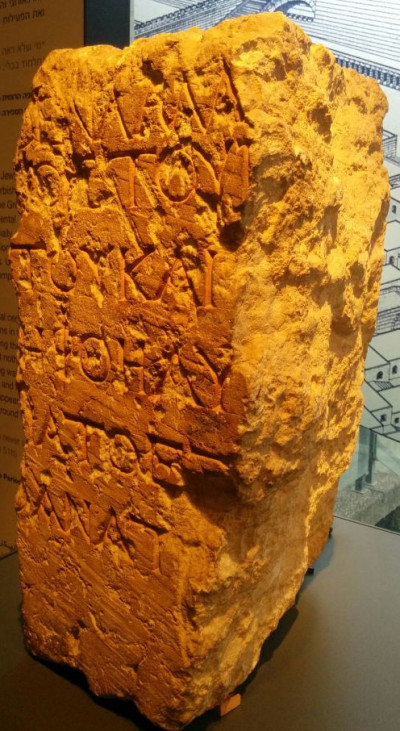
The pictured stone was found in 1935. It was actually the second such warning-stone to be found, the first being discovered by Charles Simon Clermont-Ganneau in 1871. This stone was deemed so dangerous to the "Jews inhabited Israel 2000 years ago" theory, that it completely disappeared for 13 years before resurfacing in Istanbul, where, it was correctly calculated, it would not attract much attention. It is now displayed in the Archaeology Museum of that city, and is pictured below:
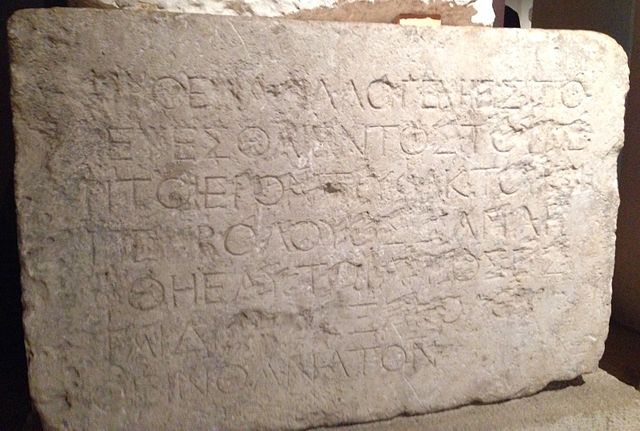
It says in Greek: "No stranger is to enter within the balustrade round the temple and enclosure. Whoever is caught will be responsible to himself for his death, which will ensue." So the famed Second Temple was actually a Greek Temple.
The oldest synagogue in Israel (is a Greek synagogue).
The word synagogue (ΣΥΝΑΓΩΓΗ) is a Greek word for a gathering of people, assembly, or meeting place. It is exceedingly strange that Jews should have chosen a Greek word to name their churches. Here is a photo of the dedication stone of the oldest synagogue in Israel. This dedication stone is all that is left of the building.
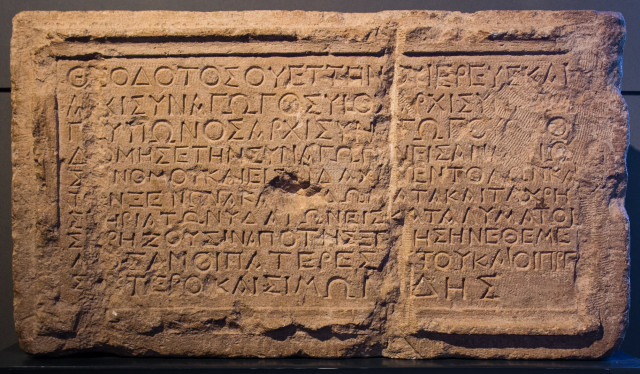
Note that the inscription is in Greek letters.
The inscription is known as the Theodotos/Theodotus Inscription. The stone was discovered by Raimond Weill in 1913 at Mount Ophel in Jerusalem. It was found dumped in a cistern. The style of the Greek characters dates it to the first century BC. It states: "Theodotos, son of Vettenos, priest and archisynagogue, son of an archisynagogue, grandson of an archisynagogue, built the synagogue for the reading of the Law and the teaching of the commandments, and guest-house and the rooms and the water supplies for the lodging of strangers in need, which his fathers founded and the Elders and Simonides."
Note that Theodotos has a Greek name. Note that his father Vettanos has a Greek name. Now, the word archisynagogos means "leader of the synagogue". So, it appears that three generations, or more, of Greeks headed the oldest synagogue in Israel.
For more about the Second Temple, and Theodotos inscriptions, click here.
I wonder why the early "Jews" hated Hebrew and loved Greek?
It should be mentioned that the Hebrew language is a dialect of Aramaic, and both are written in variants of the Jewish script, which is also called the Aramaic square script, or the Hebrew square script. The letters can vary somewhat but are recognizably the same as those of modern Hebrew.
A Challenge.
Name one, just one, ancient city (that existed in what is now called Israel) where the majority of the building inscriptions are in Hebrew, or Aramaic. Then give a summary of some "ancient Jewish architectural style". You will have to make this up as it does not yet exist. Then show that the buildings of this city are constructed in the "ancient Jewish architectural style" that you have just invented. Bet you can't do it!
More Ancient Greek Synagogues.
Sepphoris (ΣΕΠΦΩΡΙΣ) was an ancient Greek city, now in ruins, about six kilometers northwest of Nazareth. Strangely, those who excavated this Greek city were unable to find the ruins of a single Greek temple, or even a Greek synagogue. However, they have uncovered what they call a "Jewish synagogue".
Pictured symbolically on the mosaic floor of this "Jewish synagogue" is the Greek sun God, Helios, and his wife, Selene, the moon God. As is common in Greek art, Helios is depicted riding on his chariot, which was drawn across the sky by four horses. Around the image of the Greek sun God is one of a number of Greek inscriptions that can be found in this "Jewish synagogue", and surrounding that, are representations of the twelve signs (a mixture of demons, animals, and gods) of the zodiac.
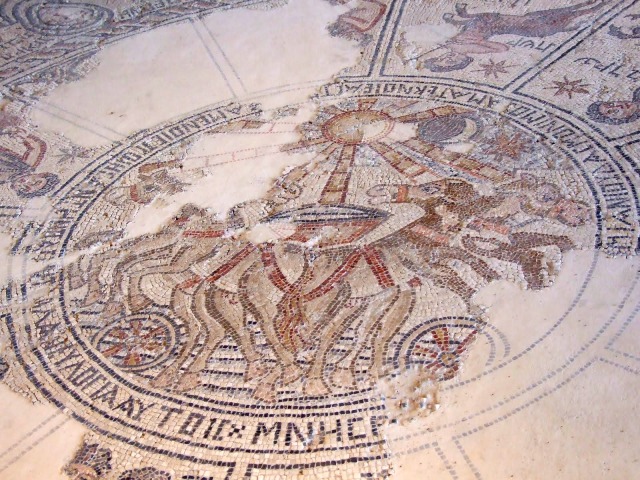
Of course, having an image of the Greek sun God in a "Jewish synagogue" is problematic, as it is a clear violation of the commandments of Moses, which state: Do not have any other gods before Me. Do not represent [such] gods by any carved statue or picture of anything in the heaven above, on the earth below, or in the water below the land. (Exodus 20:3-4)
Some have tried to escape the violation by noting that Ηελιος, Ηλιος, Αλιος, Ηλος, Αλ, and Ηλ are all names referring to the Greek sun God. The last name, Ηλ = El = אל, which is the usual Greek word for the sun, is also a name for the Jewish God. Hence, they conclude that Helios, and the Jewish God, are the same God, and therefore (technically) there is no violation.
Excavations at Sepphoris have revealed more than sixty other colorful mosaic carpets. Many feature scenes from Greek mythology, for example, those found in the "House of Dionysos" and the "House of Orpheus". Dionysos was known as the Son of God, that is, the Son of Zeus, and Orpheus was another Greek God, who, in his human form, was a great teacher of men. This ancient city had a large number of residences, an advanced water supply system, public toilets, and an ancient Greek theater that seated 4,500.
Incidentally, the Greeks (later in conjunction with the Romans) built many sophisticated water supply systems throughout what is now Israel, Syria, and Jordan. For example, the Qanat Fir'aun. This was an engineering wonder, 177 kilometers in length, with tunnel sections totaling 106 kilometers. It was built to bring water to the Dekapolis cities of Gadara, Adraha, Abila, and Raphon. The Dekapolis were ten Greek cities built mainly in the dry area, east of the Sea of Galilee. They defined a region where twenty, or more, cities were eventually built. Such, would have been impossible without the advanced technology of the Greeks (and Romans).
Tiberias (ΤΙΒΕΡΙΑΣ) is an ancient Greek town, now in ruins, on the western shore of the Sea of Galilee. Strangely, those who excavated this Greek town were unable to find the ruins of any Greek temple, or even, Greek synagogue. However, they have uncovered what they call "Jewish synagogues", three of them. Pictured on the mosaic floor of one of these "Jewish synagogues" is the Greek sun god Helios. As is common in Greek art, Helios is represented with the rays of the sun radiating from his head, and like at Sepphoris, he is pictured at the center of a zodiac.
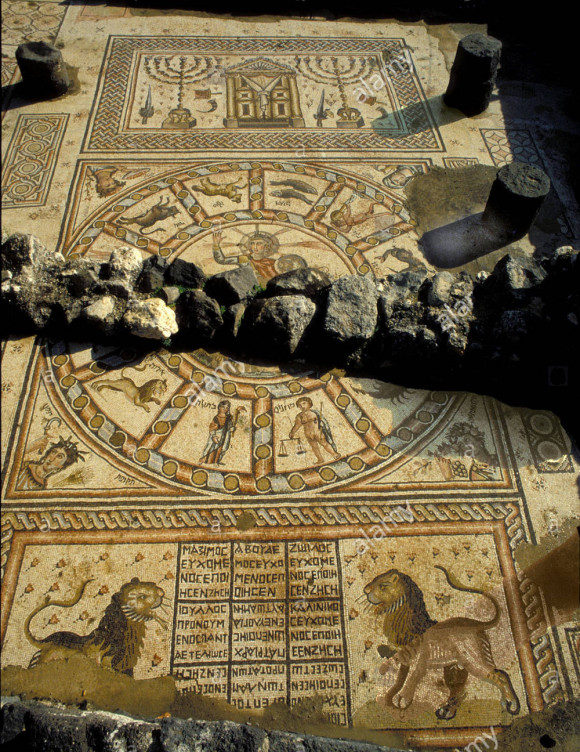
Here, the image of the Greek sun God is even more problematic, as, not only is it a clear violation of the commandments of Moses, but the globe and scepter held by Helios are symbols explicitly forbidden in the Mishnah. As is typical of all these "Jewish synagogues" this one has a number of Greek inscriptions. There are two long Greek inscriptions, one visible at the bottom of the above photo, and another in an adjoining room. There is also a dedication (pictured below) to the mosaic artist, or donor, or perhaps the owner of the building, stating: Founded by Procolus son of Krispus. Note the Greek lulav and ethrog. Together with the menorah, these religious symbols have been stolen by the Jews, and are now claimed to be exclusively of Jewish origin.
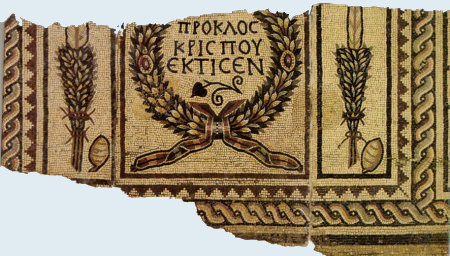
The history of Tiberias was once taken from a work of Flavius Josephus, called "Jewish Antiquities." However, it has become exceedingly clear that Josephus cannot be relied on for historical fact, and his history of Tiberias has been quietly dropped. A new history of the town, hopefully more accurate, can now be pieced together. Josephus was a writer of mythology who wrote in Greek. He called himself Ιωσηπος Ματθιου παις, that is, Josephus, son of Matthew. Matthew is a Greek name, so Josephus wrote in Greek and had a Greek father (actually, Josephus is also a Greek name, but some would debate this). He also claims to have been a Jew (not the modern variety). His story of the Roman sack of Jerusalem, is pure mythology.
If you look closely at the zodiac rings of both of these "Jewish synagogues" you will see that the signs of the zodiac are labeled in a script that looks like Hebrew. We are told that these labels are in the Aramaic language. [Aramaic, and Hebrew, are very similar languages, which are generally written in the same script, although the look of the script can vary somewhat.] Since the evidence overwhelmingly points to these being Greek buildings, one suspects that these Aramaic labels have been added at a later date. This would have been after the conquest of the area by the Arabs around 635 AD, and possibly as late as the 1900's, in the on-going attempt to create an early Jewish history for the area.
There is another building, perhaps a Greek synagogue, among the ruins of the Greek Decapolis city of Scythopolis (ΣΚΥΘΟΠΟΛΙΣ), that contains a mosaic floor featuring a zodiac. The area of Scythopolis which contains this building has been given the name Beth Alpha (probably because the name Scythopolis was too obviously Greek) and the building named the Beth Alpha synagogue. Here too, the Greek sun god is at the center of the zodiac. Here, most of the inscriptions are in Aramaic/Hebrew. But, even in this building there is a Greek inscription, which says: "May the craftsmen who carried out this work, Marianos and his son Hanina, be held in remembrance!"
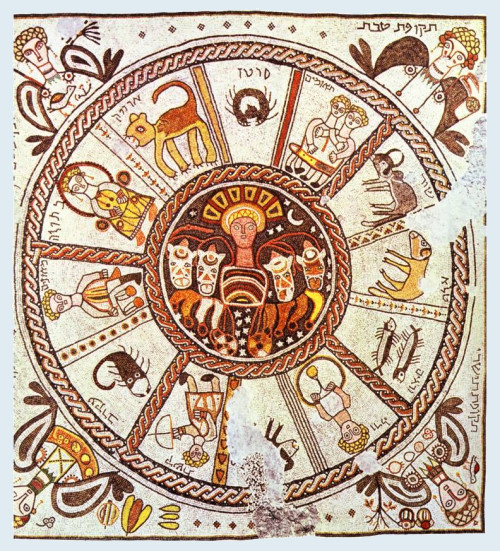
As to the main Hebrew/Aramaic inscription, the archeologist, E. Sukenik, states, "The work was done by craftsmen who were apparently ignorant of the Hebrew script...." which seems rather unusual. It should also be noted that this particular zodiac was added long after the building was constructed, as there is another mosaic carpet beneath it. One of the features that marks this zodiac as clearly Jewish, is the particularly thin noses of all the images of the Gods and Heroes. The fact that they are all blond is also of vague interest.
For a long time, Aramaic has meant the language of the Babylonian Talmud. There is a very similar language found in the Jerusalem Talmud. The first is often called eastern-Aramaic, and the latter, western-Aramaic. Together, they are called Talmudic-Aramaic. Eastern-Aramaic has traditionally been (incorrectly) called Chaldean, and Assyrian. Talmudic-Aramaic is written in various forms of the Hebrew square script (some less square than others). More recently, the term Aramaic has been used for a collection of languages, the Aramaic language group, which includes Talmudic-Aramaic, Syriac, Nabatean, Palmyrene, and Hatran. Even though Hebrew is very similar to Talmudic-Aramaic, for political reasons, it is not included in the Aramaic language group, but is part of the Canaanite language group.
It is often claimed that western-Aramaic was spoken by the people who lived 2000 years ago in what is now called Israel, but this was not the case. The Jews only arrived in that area after the Arab conquest of Greek Christian Palestine, around 635 AD. These Jews settled mainly in Tiberias. In like fashion, colonies of Jews sprung up in Syria (especially Damascus and Aleppo), Egypt (especially Cairo), and Iran, after the Arab conquest of these areas. After the Arab conquest of North Africa, colonies of Jews sprung up across North Africa. After the Arabs conquered Spain, in 715 AD, colonies of Jews sprung up in Spain. Initially, all these widely flung colonies spoke the same Aramaic/Hebrew. However, over time each (to a greater or lesser extent) developed their own dialect. In this way the Aramaic language spread over an extensive area, but it was generally only spoken by Jews. The language of the conquered peoples usually became Arabic.
As a language, Talmudic-Aramaic is closest to Mandaic, a language from southern Iraq. The square script is similar to the Nabatean (an Arab people who lived east of the Jordan river) script, and the Palmyrene (a people who lived in eastern Syria) script. This evidence suggests that the cultural homeland of the (people currently called) Jews, is Iraq (Babylon). Their presence in Iraq before the Arab conquest seems sound. Evidence for their presence in Palestine, before the Arab conquest, however, consists mainly of ancient buildings appropriated from others, various Talmudic-Aramaic inscriptions from after the Arab conquest, and the many fake inscriptions carved in the continuing attempt to create an early Jewish history for the area.
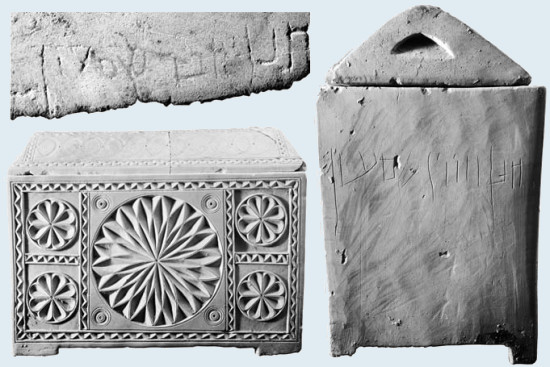
About eighty percent (why this extraordinarily high percentage?) of the Aramaic/Hebrew inscriptions from the Jerusalem area are on ossuaries. The above ossuary is fairly typical. It has two inscriptions, one in small letters on the decorative face, and one on the side. Both say, Hananiah son of Shimon. It has been dated to the first century BC. One immediately notices that the inscriptions seem to be the scribbles of a child, whereas the ossuary itself has been carved from the stone with the utmost care. This contrast is exceedingly common. Why would those who paid for a beautiful decorative work, allow such scribble on the same piece? And, one doubts that Jews would appreciate being dug up a couple of years after burial, so that their bones could be placed in an ossuary. It appears that many of these ossuary inscriptions have been faked.
It turns out that this "typical ossuary" is actually rather exceptional, as the inscription Hananiah son of Shimon has been scratched, in the same peculiar scribble, on ossuaries at three separate Jerusalem sites. Could the fraudsters have really been that stupid that they inscribed the same father and son combination on three separate ossuaries (and twice on each ossuary). For photos, and descriptions of the three ossuaries, click here.
So, why would the ossuary inscriptions be faked? Well, if we investigate the work "Corpus Inscriptionum Iudaeae Palaestinae: Jerusalem. A multi-lingual corpus of the Inscriptions from Alexander to Muhammad," on Jerusalem inscriptions, and exclude the ossuary inscriptions, all 564 of them, then there are 633 inscriptions left, 463 of them Greek, 72 Latin, and 98 Hebrew or Aramaic. 98 is an embarrassingly low number of Hebrew and Aramaic inscriptions for what was once "the most Jewish city in the world". People may start to ask why there are nearly five times as many Greek inscriptions. Where did all those Greeks come from? So, they were faked to bolster the numbers. Of course, if you look elsewhere, the statistics are in even more need of attention. For example, the Middle Israeli Coast, with 748 Greek, 244 Latin, and 18 Hebrew or Aramaic inscriptions.
The following table gives a summary of the languages of the inscriptions found in the six volumes of "Corpus Inscriptionum Iudaeae Palaestinae: A multi-lingual corpus of the Inscriptions from Alexander to Muhammad." Volumes 1 & 2 being "Jerusalem;" volume 3 being "Caesarea and the Middle Coast;" volume 4 being "South Coast;" volumes 5 & 6 being "Iudaea Idumaea." These volumes contain some inconsistances; volumes 1 & 4 contain ostracon inscriptions, but volumes 2 & 3 do not; volumes 1 & 4 contain ossuary inscriptions, but 2 & 3 do not; volumes 2 & 4 contain stonemason's marks, but 1 & 3 do not. Therefore, the inscriptions on ostracons, inscriptions on ossuaries, and the stonemason's marks have been excluded from the tally. Inscriptions that could be viewed as either Hebrew or Aramaic have been split half and half beween Hebrew and Aramaic. Inscriptions that could be viewed as either Greek or Latin have also been split half and half.
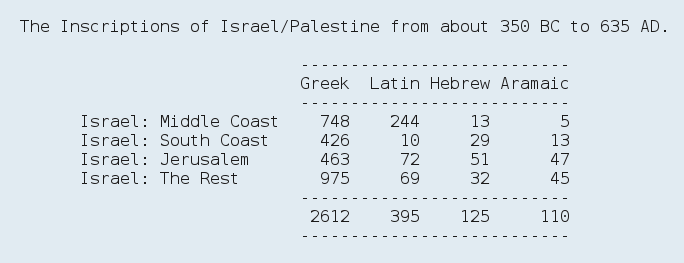
Many fraudulent "Hebrew" inscriptions have been produced simply by adding the word peace, in Hebrew, to an existing Greek inscription. Often, even though care has been taken to carve the added word in the same style as the original, it is still clear that it has been added by a different hand. An example is pictured below. The Aramaic ostracon inscriptions are also highly likely to be fraudulent. When all the fraudulent, and miss-dated cases, are removed from the tally, one suspects that there will be no real Hebrew or Aramaic inscriptions (from before the Arab conquest) left.
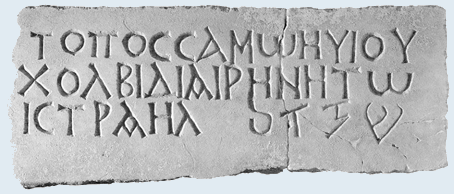
By one of today's definitions, Aramaic is the language spoken by Aramaeans, the people living in Aram, the area around Damascus and in northern Syria between the Tigris River and the Taurus Mountains. The oldest inscriptions in this particular Aramaic language are from northern Syria. They are written in the Phoenician script. Even though the Phoenician script looks nothing like the Hebrew square script, or its Aramaic variants, it is often called paleo-Hebrew. It is claimed that the Hebrew script gradually evolved from the Phoenician, but I find it hard to believe that the natural evolution of a script, is from one were the letters are reasonably well differentiated, to one, like Hebrew, were numerous letters look the same, and consequently, before modern times, must have been a complete nightmare to use. The Phoenician script is, in reality, a specific example of archaic-Greek. According to the literature, almost all of the Phoenician characters can be found among the many early versions of the Greek alphabet.
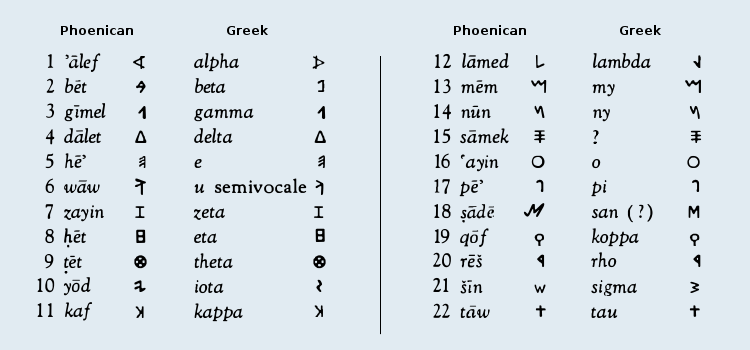
To show how similar the Phoenician alphabet is to archaic-Greek, I have copied the table from page twenty of the book "L'epigrafia Greca dalle origini al tardo impero" [Greek epigraphy from origins to the late empire] by Margherita Guarducci. The table speaks for itself. Although, it must be mentioned that not all the entries of the table are sound. The pictured variant of the Greek alpha has been found only once. This was as graffiti on pottery. This could have easily been forged, and undoubtably was. The piece of pottery in question, was offered to archaeologists as recovered loot from tomb robberies that were said to have occurred in Athens, and the graffiti, with this history, was inexplicably accepted as genuine.
Further forgeries, the Fayum Alphabet tablets, and the Würzburger Alphabettafel, are of interest here. The story behind these tablets requires you to believe that around 800 BC, a scribe (obviously an apprentice) located in Fayum, Egypt, was given four copper (which in those days was as valuable as gold) tablets, each about 21 cm by 13 cm, on which to practice his writing skills. After an hour or so, the scribe completely filled the tablets with multiple copies of an early Greek alphabet, which he then discarded, or lost, in his garden. There the tablets remained until discovered some 3000 years later, when it was observed that this alphabet was similar to other early Greek alphabets, but consisted of only the first 22 characters (from A to T), and was written retrograde, just like the Phoenician alphabet. If you believe this drivel, then I have a bridge to sell you. These copper tablets were clearly fabricated to "prove" that the Greek alphabet derives from the Phoenician alphabet. It is not clear why the fraudsters adopted such a transparently false cover story.
For more about these forgeries, click here.
Guarducci presents her table to convince the reader that Greek writing derives from Phoenician writing. But is this true? The table can also be used to show that the Phoenician script is derived from the Greek. The Greeks had been using the Linear-B syllabary to write Greek for centuries before the Phoenician script existed, and an alphabet without vowels, such as the Phoenician, had nothing to offer the Greeks. Conceptually, syllabaries, like Linear-B, are one large step up from alphabets without vowels, as they actually express the vowels. However, they do this in an inefficient way. Each consonant+vowel sound is given its own symbol. When it was realised that each consonant+vowel sound could be written as a consonant symbol followed by a vowel symbol, this reduced the number of symbols needed, and simplified the writing of the language. In fact, the Greek Linear-B was a very advanced syllabary, as the vowels had already been recognised, and separated out. Thus the hard bit had been done, and the Greeks were well on their way towards a modern alphabet. And all this, long before Phoenician writing even existed.
It should be stressed that Linear-B was an advanced writing system, and an extensive literature would have been written in it if the more efficient Greek alphabet had not been developed. Sanskrit is usually written in the Devanagari script which is a syllabary, and thousands of books, many of a complicated nature, have been written in it. One should also mention the Chinese script, which clearly shows how unimportant an efficient alphabet is to the development of a sophisticated culture. It is possible that the sudden emergence of the Greeks from their dark-age, was due to many books written in Linear-B being transliterated into the new Greek script at the one time. Perhaps, Homer was actually written hundreds of years before it was transliterated into the new Greek, around 800 BC. If this is correct, then it is obviously hopeless to search for an historical Homer.
Notice that contrary to what is claimed, the Phoenician alphabet actually has vowels. They are alef, he, waw, het, yod, and ayin, and these correspond to the Greek vowels alpha, e, u, heta, iota and o. The same can be said for Hebrew. That the Phoenicians did not usually write these vowels, is probably due to the fact that when they adopted the Greek alphabet, they didn't consider them important, just a nuisance, since, it was usually obvious (to them) what was meant from just the consonants (and context). And, if the meaning wasn't completely clear, they did actually write the Greek vowels (matres lectionis). It was like some nation, in adopting the French alphabet, borrowed the letters, but not (usually) the accents, because the accents seemed unimportant, unnecessary, and a pain to write.
As an example of this retention of Greek vowels, note that when the Greek word Αδαμ (Adam) was transliterated into Hebrew, the vowel A = א was retained, producing the Hebrew word אדם for Adam. This is how a language "without vowels" ended up full of vowels. Sometime around the ninth century AD, the Jews realized that it would be a good idea to indicate the vowels. However, instead of using the vowels inherent in the language, they created a new system indicating the vowels by dots and other small symbols (which actually differentiates the vowels better than, say, English). This also distinguishes the Jews as a people that having been given an alphabet with vowels, didn't know how to use them.
Remnants of other mosaic floors featuring zodiacs, in what is now Israel, can be found in buildings at Huseifa, Na'aran, and Susiya. The dates assigned to these "Jewish synagogues" containing zodiacs are; Tiberias, 4th century AD; Huseifa, 5th century AD; Na'aran, Susiya, and Sepphoris; 6th century AD. Of course, similar zodiacs featuring the Sun God can be found in many places throughout the old Greek and Roman world. Here is a 3rd century example from Münster-Sarnsheim, Germany.
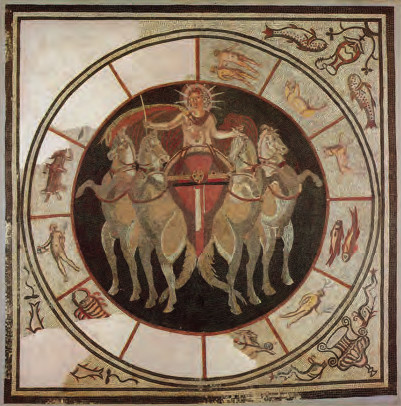
Beautiful mosaic floors often adorned the homes of well-to-do Greek and Roman citizens. Below, is a 5th century mosaic from a Greek residence in Jerusalem. It features the Greek God Orpheus (wearing a Phrygian cap) playing his lyre, and charming the animals. His music was reportedly divine, and able to soothe all living beings, and even stones. The Jews (who followed the Arabs into the area) sometimes added the word David, in Hebrew, to mosaics that were quite clearly of Orpheus. This tells us that they identified (at least to some extent) David with Orpheus.
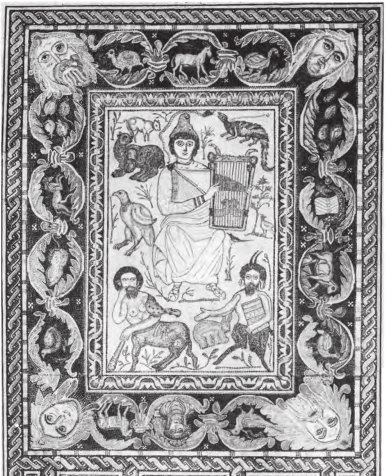
The following mosaic is from a residence of the Greek city of Heliopolis. Surrounding Calliope (the Goddess of eloquence and poetry) are depicted Socrates and the Seven Sages (Chilon of Sparta, Pittakos of Lesbos, Periander of Corinth, Cleobolus of Lindos, Bias of Priene, Thales of Miletus, and Solon of Athens).
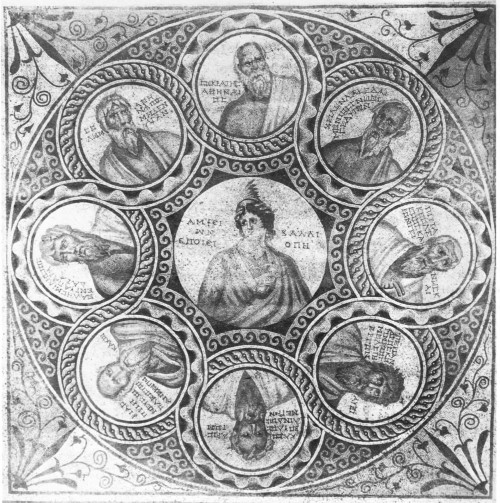
Heliopolis (the city of the Sun God) was a large Greek, and later Roman, religious center about a hundred and twenty kilometers north of Israel (near the town of Baalbek in Lebanon). Ptolemy (one of the Greek dynasty that ruled Egypt for centuries) included Heliopolis among the Decapolis cities. Heliopolis was home to the largest temple complex in the Greek and Roman world. This included the two largest temples of that world, the temples of Zeus (Jupiter) and Dionysus (Bacchus). One has to wonder if Heliopolis was once the center of the very early Greek world. Although now in ruins, the temple complex is still mightily impressive. Only six of the massive 22 meter high columns of the Temple of Zeus are still standing. But the smaller Temple of Dionysus, which is still a massive structure (larger than the Parthenon in Athens) survived comparatively intact. It has been partly restored. Here is a photo:
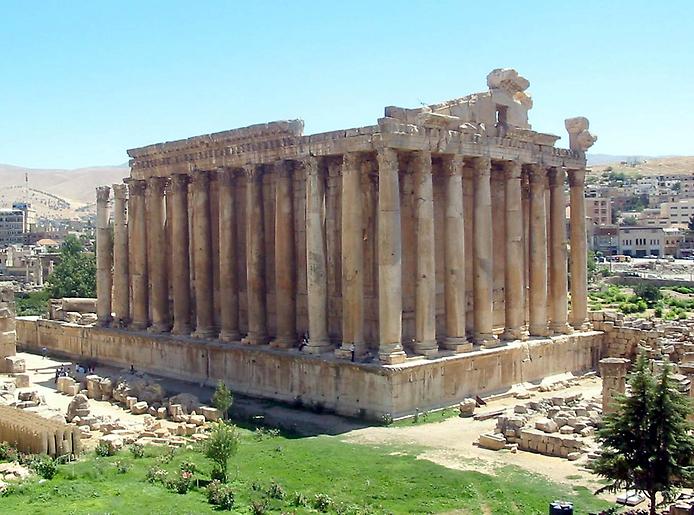
For an idea of its colossal size, look for the man in front of the second column back from the closest corner. Three blocks of stone, each weighing about 1000 tonnes, have been used as part of the foundation for the Temple of Zeus. They are from a quarry about a kilometer away. Another three massive shaped stones (bricks) can still be found in the quarry. These three are estimated to weigh 992, 1104, and 1674 tonnes. Below, is a picture of the smallest of these three. The temples of Zeus and Dionysus can be seen in the background. How these stones were moved, no one knows.
For more about Heliopolis and these enormous building blocks, click here.
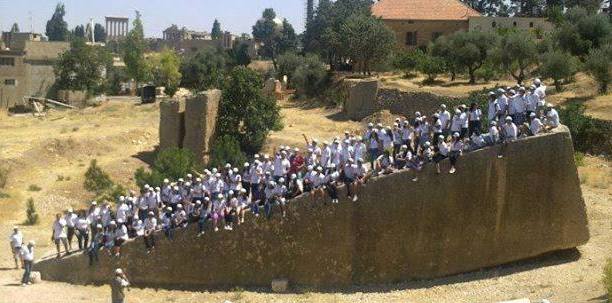
Getting back to the topic of Greek synagogues. Gaza was a very old Greek city-state. In Gaza, there is another "Jewish synagogue", which is, of course, in reality, a Greek building, perhaps even a Greek synagogue. It has a beautiful mosaic floor, which is pictured below. Note the inscription in Greek letters.
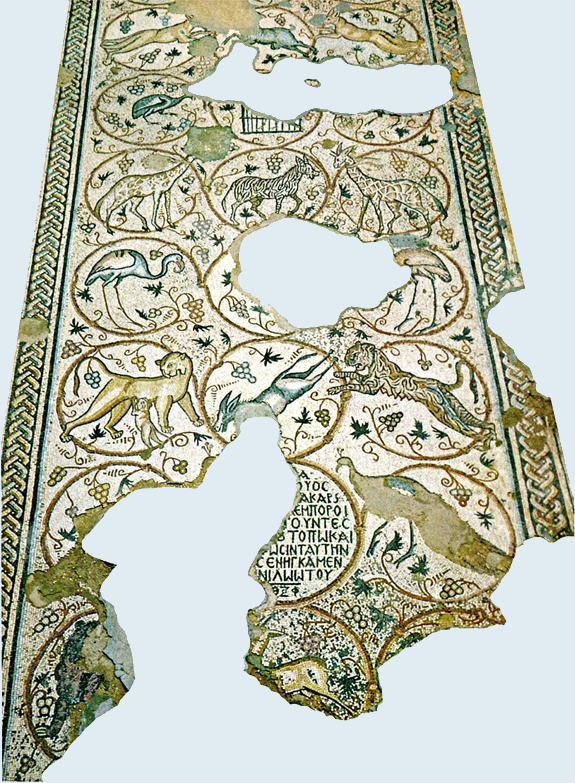
There is another interesting mosaic in the Greek Decapolis city of Scythopolis. Here, we have the Greek Sun God Helios, and his twelve disciples (the months) together with his wife, Selene, the moon God.
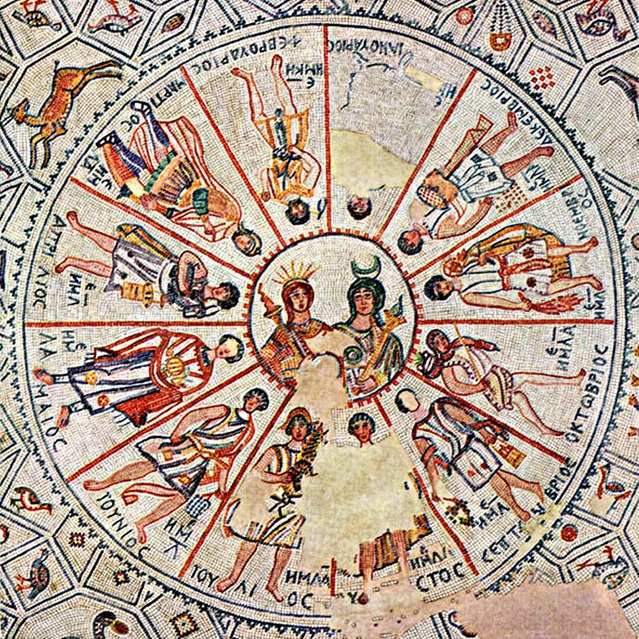
There is another famous "Jewish synagogue" at Dura Europos, in eastern Syria, near the border with Iraq. It was initially thought to be a Greek temple, which, of course, it was. The temple contained many beautiful paintings, mostly of Biblical scenes. Here, is one:
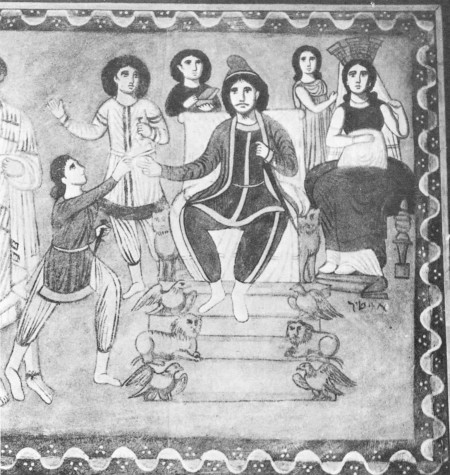
The scene is supposedly of Ahasuerus (sitting on Solomon's throne) and Esther (on the right). Note that Ahasuerus is wearing a Phrygian-cap, which tells us that the word in Jewish letters, below Esther, was likely added when this Phrygian-Greek temple was upgraded to a "Jewish synagogue".
So, who were these Greek speaking people?
These buildings; where the building's messages to the world were written in Greek; where the buildings were adorned with images of Greek gods and scenes from Greek mythology; Who built them? The answer to this question is found in the mythological scenes themselves, in which many of the characters wear a Phrygian-cap, a cap peculiar to the Phrygians. In the mosaic floor from the "Nile House" in Sepphoris, pictured below, both riders are wearing Phrygian-caps. [The left rider is probably the god Mithra. Mithra exhibited both male and female anatomy, and, of course, wore a Phrygian-cap. Note the breast below the arm.]
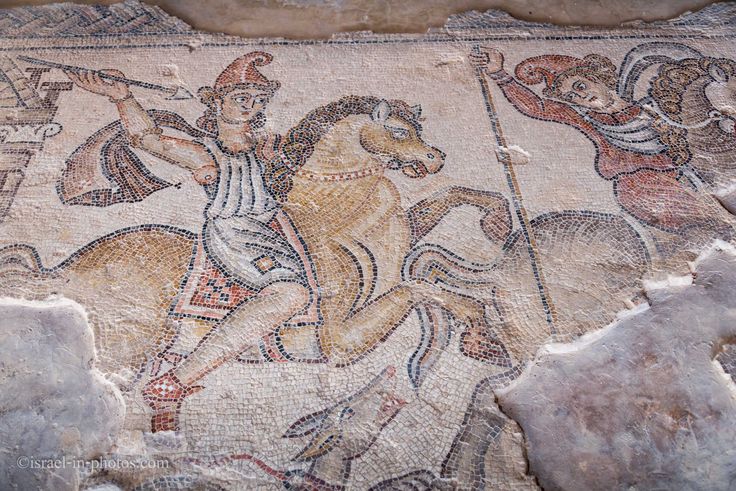
Now the Phrygians were a numerous people that inhabited the land of Phrygia, a large part of what is today Turkey (Asia Minor), and, it appears, also the coastal regions of the eastern Mediterranean. They spoke and wrote an archaic form of Greek. Phrygian-Greek is very old. Some archaeologists, for example, H. Schliemann, are also of the opinion that Greek architecture was initially developed by the Phrygians. The Phrygians were well known in the ancient world. They were considered one of the oldest races of Asia Minor and their mythological tales were mentioned by many early authors. In Strabo's time, he was able to state that the then Phrygian capital, Apameia (Απαμεια), was second only to Ephesus in all of Asia Minor. Being a large metropolis, Apameia had its own mint where the following coins were struck.
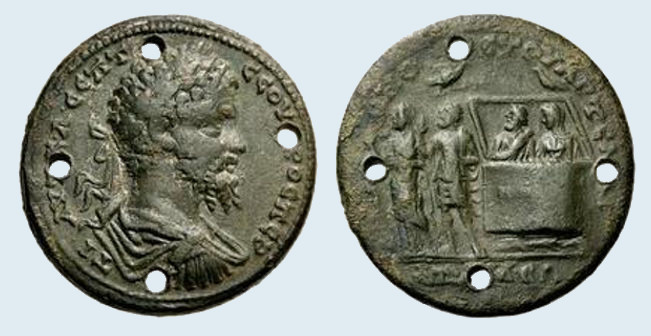
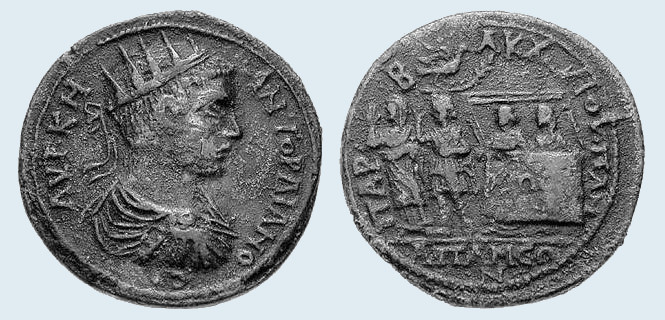
The Phrygians had some story about a man they called NΩE (pronounced Noah) who entered an ark to escape a flood. It seems that two birds (perhaps a dove and a raven) played some part in the story. We are told that this story is illustrated on the above coins. On these coins we see NΩE and his wive in the ark, and again, on the shore giving thanks to God. There are two birds and one is shown carrying a small branch, perhaps an olive branch, and although not visible on these particular coins, we are told by various numismatic journals that there exist coins where the name NΩE is clearly imprinted on the side of the ark.
Between the years of 192 and 253 AD, at least six Graeco-Roman Emperors (Septimius Severus, Macrinus, Severus Alexander, Gordian III, Philippus I, and Trebonianus Gallus) minted similar coins featuring Noah and his ark. Most other coins from the Phrygian mint feature regular Greek Gods, or Greek mythological scenes, and symbols. In particular, Athena (the goddess after whom Athens is named) features on a large percentage of these coins.
This Phrygian flood story is recorded in the "Sibylline oracles" which are said to be (at least partially) of Phrygian origin. The Sibylline oracles feature a strange mix of Greek and Biblical characters; like Kronos, Adam, Rhea, Noah, Dionysus, Sabaoth, Apollo, Solomon, Titan, Gaia, Serapis, Hades, and more. The flood story runs parallel to the Biblical story. Here is a short passage from it:
But when the ark had tossed here and there on the furious waves,... and was made fast upon the narrow shore. There is upon the Phrygian main-land dark, a steep, tall mountain, Ararat by name, because thereon all were to be restored.... There the great river Marsyas draws his streams. There the ark rested on the lofty height, the waters ceasing. Then again from heaven uttered the holy voice of the great God this word: “O rescued Noah, faithful, just, come boldly forth with thy sons and thy wife, and their three young wives, and fill all the earth,...”
This tells us that the ark came to rest on a mountain called Ararat (so called because mankind would rise anew from there) which was at the head of the river Marsyas. It turns out that the river Marsyas has its head in the mountains near Apameia, so that, the city of Apameia was at the base of the mountain Ararat. So it was that Apameia received the name Απαμεια κιβωτoς or Apameia of the ark. The Greek word κιβωτoς (kibotos) is the word used in the Bible for Noah's ark, or more precisely, the word used in the Septuagint (the ancient Greek text that contained all the books of the Hebrew Old Testament plus a dozen more) and in the New testament. It means box, or chest, which is exactly what is portrayed on the coins.
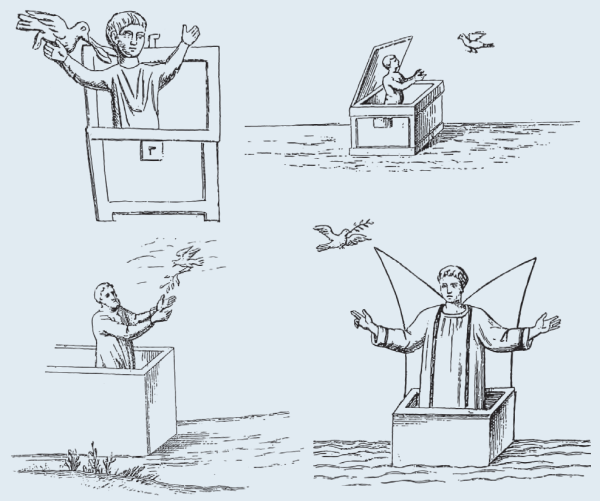
The Septuagint also uses the word kibotos for the ark of the covenant. In like fashion, the Vulgate (one of the Latin Old Testaments) uses the word arca for both Noah's ark, and the ark of the covenant. Now the Septuagint and Vulgate represent distinct branches of the Old Testament family tree, so we can be sure that the oldest versions of the books of the Old Testament used the same word for both arks. However, the Masoretic text uses different words (thebah for Noah's ark, and aron for the ark of the covenant). How can this be explained? One thing this does show, is that the Greek and Latin versions of the Old Testament are not translations of the Hebrew text.
The Mishnah is the earliest written work of the Jews. It consists of Jewish (and foreign) stories that have been handed down orally for generations, and commentary on these stories. It does not include any of the books of the Old Testament, but there are several hundred allusions to the Old Testament. These are usually one or two sentences that are introduced by the words, "it is written". At this point, the Old Testament was not held sacred, nor particularly authoritative, and was not studied in its own right, but was used to bolster the commentary on the oral stories.
The Mishnah does not mention Noah's ark and uses the word thebah for the ark of the covenant. The word thebah is related to the Greek word theba (θιβα, θιβις, θηβη) for an ark. The word theba was used by the Greek lands of Boeotia, Cilicia, Ionia, Attica, Pthiotis, Cataonia, and Syria. Each of these had a city called Thebes, which was their name for the "city of the ark". In the Phrygian language the word kibotos was used instead of theba. Recall that the Masoretic text uses the word aron for the ark of the covenant. How can this be explained? Did the Jewish Rabbis have so little respect for the ancient text, that they changed words to suit their tastes?
Shortly before the Mishnah was committed to writing, one of the Greek Old Testaments (possibly a Syrian version) had been translated into the Aramaic of the time, to produce the consonantal text of the Hebrew Old Testament. This had allowed enough time for the Old Testament's fragmentary inclusion in the Mishnah, but not enough time for the Old Testament to penetrate deeply into the Mishnah's structure.
In the following centuries the Mishnah and the newly translated Hebrew Old Testament were woven together in a systematic study of the Mishnah, to produce various documents called Talmuds. Different areas produced different Talmuds. Two Talmuds became well known, the Babylonian Talmud and the Jerusalem Talmud. Having Jerusalem (this would have been the heavenly Jerusalem, not a city on Earth) in the title, it was claimed that the Jerusalem Talmud was written in Palestine, but this was not the case. During this period, verse-by-verse commentaries of the newly translated Hebrew Old Testament were also produced.
So, the Greeks who built most of the buildings in the area now called Israel, were Phrygians, or were closely related to the Phrygians. This is why most of the existing inscriptions are in Greek letters. This is why the Phrygian-cap is prevalent. These Phrygian-Greeks wrote the Sibylline oracles which contain a mixture of Greek and Biblical characters. They struck coins in honor of their flood hero, Noah. They also struck coins in honor of Zeus, Athena, and other standard Greek Gods.
Plutarch tells us of the Phrygian sacred books. But where are they? What happened to them? It appears that the Phrygian sacred books were indeed many, and included all of the Old Testament books, Genesis, Exodus,... etc, together with a host of books now described as apocryphal, or pseudepigraphal, for example, the books of Adam and Eve, the Apocalypse of Moses, the Apocalypse of Abraham, the Apocalypse of Ezra, the Martyrdom of Isaiah, the Testaments of the twelve Patriarchs, the Ladder of Jacob, the Sibylline Oracles, the Assumption of Moses, the Book of the Secrets of Enoch, the other books of Enoch, the Syriac Apocalypse of Baruch, the Greek Apocalypse of Baruch, the other books of Baruch, the books of Esdras, Tobit, the Psalms of Solomon, the Wisdom of Solomon, the Prayer of Azariah, the Lesser Genesis, Ecclesiasticus, the Epistle of Jeremiah, the Prayer of Manasseh, and many more.
The oldest extant manuscripts of the Old Testament books are in Greek. The oldest extant manuscripts of the additional books are found in various languages; Greek, Latin, Slavonic, Ethiopic, Armenian, Coptic, and others, but never in Hebrew. Most of these old manuscripts written in Latin, Slavonic, Ethiopic, Armenian and Coptic, show evidence of having been translated from Greek. To state, as is usually the case, that all these books have been translated from Hebrew originals, and that these Hebrew originals are now lost, is absurd.
As an example of internal evidence that proves translation from a Greek original, consider the following quote from the Slavonic, "Book of the secrets of Enoch." The context is God speaking to Enoch; "On the sixth day,... I made man.... And there was no one like him upon the earth of all My creations. And I gave him the name AΔAM (ADAM) from the four substances (gathered from the four corners of the world): Aνατολη (the East), Δυσις (the West), Aρκτος (the North), and Mεσημβρια (the South)." That is, God made Man from material (dust/earth) from the four corners of the world, and God gave Man the name ADAM (which is composed of the first letter of each of the Greek names for these corners) to symbolically represent this. Now this only makes sense in the Greek language and proves that the book was originally written in Greek.
For more about Adam being a Greek name, click here.
At some point, various books that seemed to belong together, were combined, for example, the Pentateuch, which combined Genesis, Exodus, Leviticus, Numbers, and Deuteronomy (notice that these books have Greek names and these names are not a translation of any Hebrew terms). Later, about fifty of these books were combined to form the Greek Old Testament. Much later, the Jews translated about forty books, from (a version of) the Greek Old Testament, into Aramaic/Hebrew, to obtain the pre-Masoretic text. Centuries later the Masoretes revisited this text (in particular, they added vowel symbols) to obtain the Masoretic text which is still used today.
So, who were the Jews (Ιουδαιος)?
So, who are the Jews (Ιουδαιος) mentioned in the New Testament? Well, it appears they were the Greeks who lived in the Greek land of Judea (Ιουδαια). Their language was Judean-Greek, which we assume was the same as, or similar to, Phrygian-Greek. This situation is analogous to the Macedonian-Greeks (Μακεδων) who lived in the Greek land of Macedonia (Μακεδονια) and spoke Macedonian-Greek. Their religion was originally based on the Phrygian stories. These were eventually written down, and a collection of them became the Old Testament. The Greeks who lived in Judea became synonymous with the believers of the religion. Who wrote the New Testament? The Judean-Greeks. Who are the Greeks mentioned in the New Testament? They were the "other Greeks," the non-Judeans. And non-Greeks? They were simply Barbarians, although with the New Testament, they were given equality with the Greeks. As to the ancient Greeks who history records as translating the Old Testament (i.e., the seventy), they translated it from Phrygian-Greek, to Koine-Greek, to produce the Septuagint, and provide the Old Testament in a language that all Greeks could read. [Koine-Greek was the standard Greek, which unified the numerous Greek dialects.]
And this helps explain various problems regarding the New Testament. For example; Why did the apostle Paul (a supposed Jew) write his letter to the Hebrews (supposed Jews) in Greek? Why didn't he write his letter in Hebrew or Aramaic? And, why did Jesus make puns that make sense in Greek, but not in Hebrew or Aramaic, etc, etc?
The Qumran necropolis.
The cemetery at Qumran contains some 1200 graves. That number was was once much larger, as the erosion of the plateau has claimed a significant portion of the cemetery. The graves are individual, and arranged in straight lines with the deceased lying supine, facing north. Those buried here are not Jews. There is a small compound, pictured below, where the deceased were bought for religious ceremonies, and the preparation of the body for burial. Animal sacrifices were preformed. The sacrificed animals were buried under pottery bowls (that were manufactured, in their thousands, at the site). Water was supplied to the compound by an aqueduct and tunnel. The water was needed to wash down the compound to prevent the spread of disease. There were a number of pools for the purification of those who came into contact with the deceased. These also served for the storage of water.
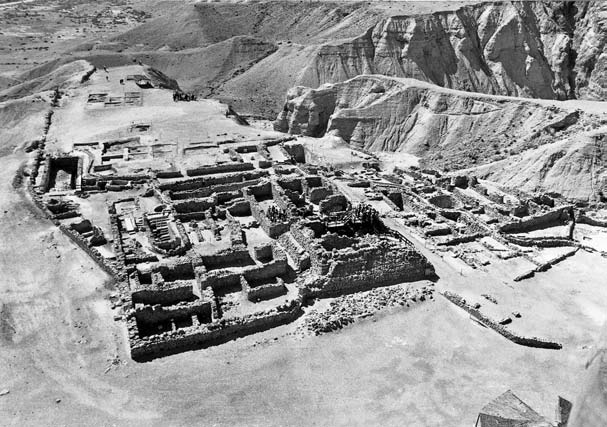
It should be emphasized that the compound is small. The square enclosure with the truncated, or collapsed, pyramid at one corner, is only about 40 x 40 meters. No residential quarters were found in, or anywhere near, the compound. Despite the compounds small size, and lack of residential quarters, it is commonly claimed that a large group of religious scholars (usually said to be Essenes) lived and studied here. Some have suggested that the scholars must have lived in the surrounding caves, or tents, but there is no evidence for this idea, and significant evidence against it. In order to accommodate at least some (estimates range from 12 to 20) scholars, it has been suggested that they lived in a bunk room on a now collapsed second floor. No effort has been spared to make the facts fit the theory. The obvious use of the compound is never mentioned.
The Dead Sea scrolls Hoax.
The Dead Sea scrolls are a mixture of old documents that were hidden in a number of caves to be found and used to support the establishment of Israel, a country intended for Jews only. The main document "finds" were in caves near the Qumran cemetery.
The first documents were "found" in 1947.
Israel was created in 1948.
In the decades following the establishment of Israel, texts were also "found" at other sites (Masada, Wadi Sdeir, Nahal Se'elim, Nahal Hever, and Murabba'at) in the Judean Desert. These, and the Dead Sea scrolls, are the only really old (well, supposedly really old) Biblical texts in the Hebrew language that have ever been found. All the previously known Biblical texts in Hebrew, date from later than 900 AD. Paul Kahle has stated:
"It is a well-known fact that Hebrew Biblical MSS dating from the tenth and eleventh centuries are very rare. The so-called Babylonian Codex of the Prophets, dated A.D. 916,... has long been regarded as the oldest dated MS of (part of) the Hebrew Bible."
Previous to the "finds", critics had pointed to the late date of the Biblical texts in Hebrew, and deduced that the Hebrew Old Testament must have been translated from the Greek Old Testament, and not the other way round. Then, low and behold, a very timely miracle occurs. The Dead Sea scrolls are "found", and dated to a thousand years earlier than the oldest previously known texts.
The critics are not given access to the scrolls, nor even photographs of the text, lest they spoil the party. In fact, for decades, only seven scholars are given access to the scrolls. This goes on until certain critics are dead and the scrolls have been purged of all anachronisms (like vowel points and Arabic numerals). Then, in 1991, only 45 years after their "discovery", the Huntington Library, in San Marino, California, without consent, makes facsimile copies of the scrolls available to all.
So that, in brief, is the Dead Sea scrolls Hoax.
More, however, can be deduced.
One can even guess where the Dead Sea documents came from.
In Old Cairo, Egypt, there is a very old synagogue called the Ben Ezra Synagogue. Like many synagogues it has a storeroom, called a genizah, where worn-out religious books were stored prior to proper burial. Unlike many synagogues, the books in its genizah were never buried, so a treasure trove of ancient texts awaited discovery.
It turns out that some of the Dead Sea documents are nearly identical to texts from the Cairo Genizah. Many are similar, not only in content, but in style, and appearance. Some, not only have the same text, but also the same scribal markings. So, it is likely that many of the Dead Sea scrolls had their source in the treasure trove, that is, the Cairo Genizah. One suspects that the Elephantine letters, and the Nash papyrus, were also from the Cairo Genizah.
One document from the Dead Sea scrolls is of particular interest, the so called "Damascus Document". Worldwide, there are twelve manuscripts of the "Damascus Document"; ten manuscripts from the Dead Sea scrolls and two manuscripts from the Cairo Genizah. There are no manuscripts of the "Damascus Document" from anywhere else. This strange distribution is a result of the fraud. It is very difficult to explain how copies of a work that is claimed to have been written by scholars at Qumran, and hidden in caves there for two thousand years, ended up in the Cairo Genizah, and nowhere else. So difficult, in fact, that no one seems to have offered an explanation. The "Damascus Document" was first published in 1910 by Solomon Schechter in "Fragments of a Zadokite Work."
The Ben Ezra Synagogue was established around 900 AD. The Arabs have ruled Egypt since they defeated the Greek armies around 640 AD. Now, the synagogue (and its Jews) existed happily, undisturbed, in the midst of the Islamic world. So, maybe the original Jews were a group of Arabs. This would explain why Hebrew and Arabic are very similar languages. This would explain why the Hebrew and Islamic religious traditions are so close. And, it would also explain why Jews turned up in Spain with the Arabs. [Similarity of language, and alphabet, indicate that today's Jews originated somewhere in the region of southern Iraq, northern Saudi Arabia, and eastern Jordan.]
Another couple of points:
The Biblical texts from Masada, Wadi Sdeir, Nahal Se'elim, Nahal Hever, and Murabba'at (twenty-five texts) are identical to the Masoretic text of the Bible, even though they were supposedly written a thousand years before. This is unheard of, and essentially proof, that Medieval documents were planted in the desert to be found by others.
It should be noted that a few Jewish scholars, in particular, Solomon Zeitlin, have long insisted that the Dead Sea scrolls were a Medieval production. Zeitlin was a well-known Talmudic scholar and would not claim this unless convinced it was true. Internal evidence from the scrolls themselves indicates a Medieval production. See, here.
It is estimated that up to 20 people occupied the site of Qumran (estimated by the number of inhabitants for whom there was room in the buildings). Now these 20 people were not just ordinary people, they read and wrote Greek, Phoenician, Aramaic, Nabataean, and Hebrew documents, like natives, and managed to write learned works on numerous religious topics (more than 900 manuscripts were "recovered"; about six hundred separate works), while gathering enough water, and raising enough food for their survival, in a desert.
And, the fact that many scrolls are written on vellum (90% of them) proves these are indeed a Medieval production. The oldest vellum manuscript to which a definite date can be assigned is the treatise of Dioscorides on Medicines. It has been assigned to the year 510 AD, or thereabouts. The earliest estimated age of any vellum manuscript was, before the Dead Sea scrolls, the second century AD. So the mythical Qumran scholars were not only exceptional scholars, but also, apparently, great innovators.
Interestingly, the 20 mythical Qumran scholars had between them, 36 copies of the Psalms, 26 copies of Deuteronomy, and 21 copies of the book of Isaiah. And all this at a time when one book was worth a king's ransom. Such extravagance! Such waste! Such an unbeliveable tale!
Anyway, I think it is clear that the Dead Sea scrolls, and the other texts from the Judean Desert, are simply a bunch of old documents that have been thrown together, planted in the desert, and sold to a gullible world.
Other popular topics are:
The Covid-19 Scam & Vaccines.
Proof that Adolf Hitler was a double agent.
A few books on Religion and Mythology (Free Downloads).
A large collection of photos of Jewish political leaders wearing skullcaps, e.g., Nelson Mandela, Tony Blair, Gordon Brown, etc.
WOW; Presidents Reagan, Clinton, Bush, Obama, Trump, and Biden are Jews.
Is it too late to save Florida from Drowning? The Conspiracy to hide Global Warming.
The free Operating System Linux running Microsoft Operating Systems on Virtual Computers (a DIY guide).
Proof that the name ADAM is of Greek origin.
